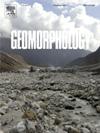From hypogenic to biogenic speleogenesis in semi-arid climate: Bat guano-driven carbonate weathering and cave modification in Chariton Cave, Israel
IF 3.1
2区 地球科学
Q2 GEOGRAPHY, PHYSICAL
引用次数: 0
Abstract
Guano-related weathering in caves received notable attention in several studies over the last decades. This study investigates the influence of bat guano on the development of Chariton Cave, the largest known hypogenic cave in Israel. We examine the cave morphology, sediments, and moisture sources to understand post-speleogenetic processes in a vadose environment. Apatite deposits along cave passages with keyhole cross-sections suggest secondary enlargement by guano-induced weathering. Estimation of the guano-related weathering suggests it accounts for at least 30 % of the entire cave volume. This significant weathering occurs in semi-arid conditions, with limited infiltration of meteoric water from the surface. However, condensation-evaporation cycles within the cave provide the moisture required for weathering associated with guano. U![]() Pb dating of calcite, which was deposited on secondary apatite, indicates bat activity in the cave since at least 5.19 ± 0.85 Ma. This age enables calculation of maximum guano-related weathering rate of ~0.05 to ~0.07 mm/ka and maximum incision rate in Chariton canyon of 19.2 mm/ky. Furthermore, 14C dating of guano shows bat activity and guano accumulation 3360–3620 years ago, which continues to the present. This research highlights the importance of biogenic processes in reshaping hypogenic caves after their disconnection from formative environments, contributing to our understanding of karst evolution.
Pb dating of calcite, which was deposited on secondary apatite, indicates bat activity in the cave since at least 5.19 ± 0.85 Ma. This age enables calculation of maximum guano-related weathering rate of ~0.05 to ~0.07 mm/ka and maximum incision rate in Chariton canyon of 19.2 mm/ky. Furthermore, 14C dating of guano shows bat activity and guano accumulation 3360–3620 years ago, which continues to the present. This research highlights the importance of biogenic processes in reshaping hypogenic caves after their disconnection from formative environments, contributing to our understanding of karst evolution.

半干旱气候下从低成因到生物成因的洞穴形成:蝙蝠鸟粪驱动的碳酸盐风化和以色列Chariton洞穴改造
在过去的几十年里,与鸟粪有关的洞穴风化在一些研究中得到了显著的关注。本研究调查了蝙蝠鸟粪对Chariton洞穴发育的影响,Chariton洞穴是以色列已知最大的地下洞穴。我们研究了洞穴形态、沉积物和水分来源,以了解洞穴形成后的过程。沿锁眼断面洞道的磷灰石沉积表明鸟粪风化作用的二次扩大。对鸟粪相关风化作用的估计表明,鸟粪至少占整个洞穴体积的30%。这种显著的风化作用发生在半干旱条件下,地表大气水的渗透有限。然而,洞穴内的冷凝-蒸发循环提供了与鸟粪相关的风化所需的水分。在次生磷灰石上沉积的方解石的UPb定年表明,蝙蝠在洞穴中至少活动了5.19±0.85 Ma。该年龄可计算出Chariton峡谷最大鸟粪相关风化速率为~0.05 ~ ~0.07 mm/ka,最大切口速率为19.2 mm/ky。此外,鸟粪的14C定年显示了3360-3620年前蝙蝠的活动和鸟粪积累,并持续到现在。该研究强调了生物成因过程在深成洞穴脱离形成环境后重塑中的重要性,有助于我们对岩溶演化的理解。
本文章由计算机程序翻译,如有差异,请以英文原文为准。
求助全文
约1分钟内获得全文
求助全文
来源期刊

Geomorphology
地学-地球科学综合
CiteScore
8.00
自引率
10.30%
发文量
309
审稿时长
3.4 months
期刊介绍:
Our journal''s scope includes geomorphic themes of: tectonics and regional structure; glacial processes and landforms; fluvial sequences, Quaternary environmental change and dating; fluvial processes and landforms; mass movement, slopes and periglacial processes; hillslopes and soil erosion; weathering, karst and soils; aeolian processes and landforms, coastal dunes and arid environments; coastal and marine processes, estuaries and lakes; modelling, theoretical and quantitative geomorphology; DEM, GIS and remote sensing methods and applications; hazards, applied and planetary geomorphology; and volcanics.
 求助内容:
求助内容: 应助结果提醒方式:
应助结果提醒方式:


